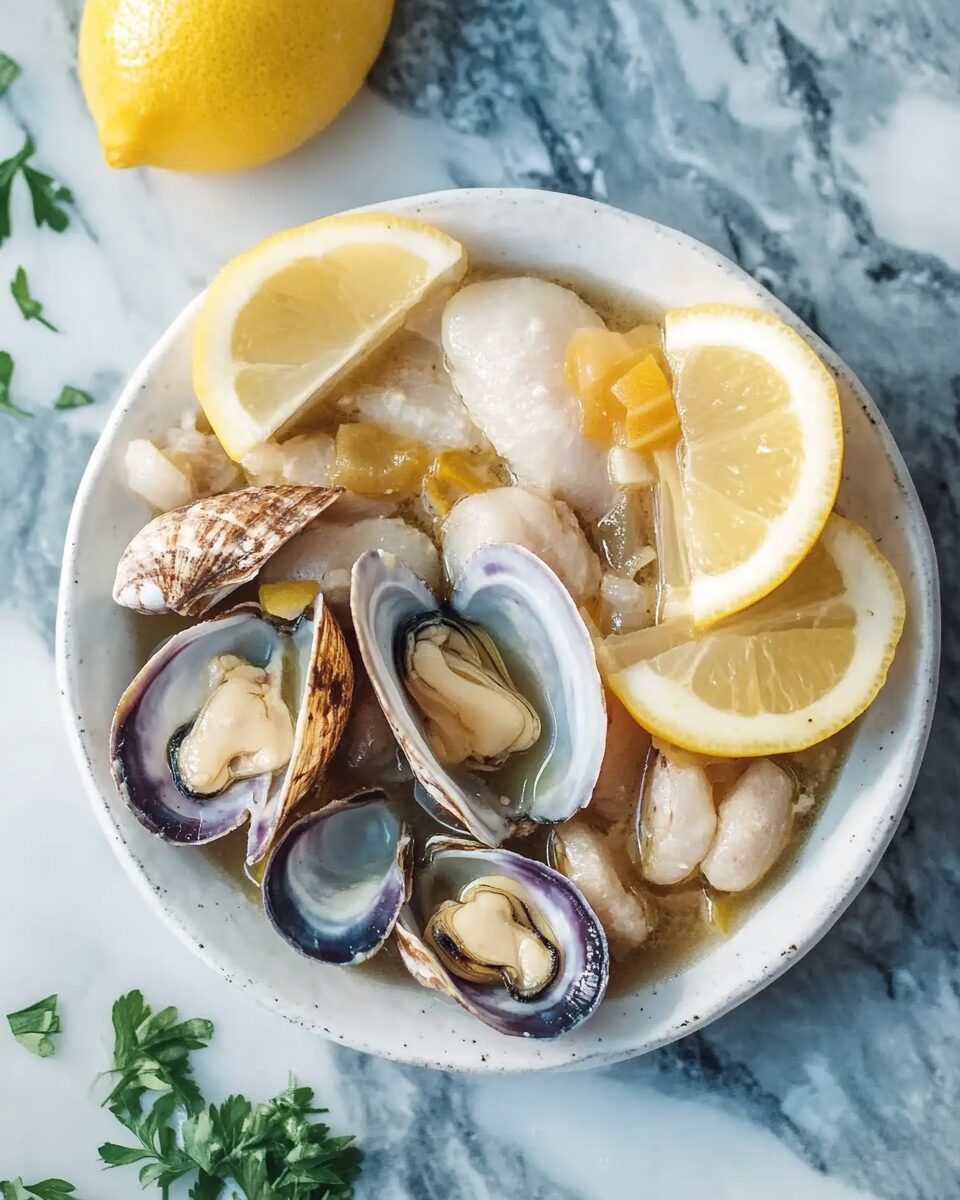Cacciucco is a hearty Tuscan seafood stew, typically served over toasted bread croutons, making it a comforting and flavorful meal. Originally a fisherman’s dish, it uses a variety of seafood, making it customizable and perfect for a variety of tastes.
Full Recipe:
Ingredients
-
1 loaf artisan bread (roughly 12 slices)
-
1 tsp garlic powder
-
1 tsp olive oil
-
2 onions, diced
-
4 garlic cloves, minced
-
6 celery stalks, diced
-
2 Tbsp parsley
-
2 tsp sage
-
1 tsp red pepper flakes (less for less heat)
-
4 tomatoes, diced fine (roughly 4 cups)
-
1 1/2 cups water
-
1/4 cup red wine vinegar
-
1 tsp salt
-
3 lbs mixed seafood (shrimp, mussels, clams, scallops, etc.)
Directions
-
Preheat oven to 275°F.
-
Cut bread into 1” cubes, spray lightly with cooking spray, sprinkle with garlic powder, and toast in the oven for 20 minutes.
-
In a large pot, heat olive oil. Sauté onions, garlic, celery, parsley, sage, and red pepper flakes over medium heat for 5 minutes.
-
Add tomatoes, water, vinegar, and salt, and bring to a simmer.
-
Add seafood and simmer for 10-15 minutes, adding clams or mussels in the last 5 minutes.
-
Serve by placing croutons in bowls and ladling the stew over the top.
Nutrients
-
Serving Size: 1 bowl
-
Calories: 247 kcal
-
Carbohydrates: 25.6 g
-
Protein: 28 g
-
Fat: 3.9 g
-
Saturated Fat: 0.9 g
-
Cholesterol: 55 mg
-
Sodium: 546 mg
-
Fiber: 5 g
-
Sugar: 6.2 g
Historical Background of Cacciucco
The origin of cacciucco is both fascinating and steeped in the history of Italian cooking. While there are many theories about its creation, the most widely accepted one suggests that the dish has roots in the humble beginnings of the region’s fishermen. Historically, fishermen would use the fish that didn’t sell in the market—those that were too small or not in prime condition for sale—to create a filling and nutritious meal. These leftovers were combined with the region’s rich supply of tomatoes, garlic, and olive oil, which were essential staples in Tuscan cooking, and simmered into a stew. This practice of using “catch-of-the-day” fish made cacciucco an affordable dish, while still being flavorful and satisfying.
The name “cacciucco” is thought to derive from the Italian verb “cacciare,” meaning “to chase” or “to throw.” This could refer to the process of tossing whatever seafood the fishermen had at hand into the pot, or it might be an allusion to the way the ingredients are quickly cooked together, creating a dish full of intense flavors. Despite its humble origins, cacciucco has evolved into a sophisticated dish enjoyed by food lovers worldwide.
The Key Ingredients in Cacciucco
One of the defining features of cacciucco is the diversity of seafood that goes into the stew. Although variations exist, a traditional cacciucco recipe often features a combination of fish, squid, octopus, and shellfish such as shrimp or clams. The freshness of the seafood is critical to the success of this dish, as it contributes to the rich, briny flavor that cacciucco is known for. The mixture of different types of seafood creates layers of flavor that meld beautifully during the cooking process.
Tomatoes form the base of the stew’s broth, adding both sweetness and acidity that complements the natural flavors of the seafood. Garlic, olive oil, and a generous helping of red pepper flakes provide the aromatic depth and slight heat that are characteristic of Tuscan cuisine. A touch of red wine or sometimes white wine is added to give the dish even more complexity. Herbs like parsley and thyme, as well as bay leaves, infuse the broth with additional fragrance, enhancing the overall taste.
Another important element of cacciucco is the bread that is traditionally served with the stew. The bread, often toasted and rubbed with garlic, is used to soak up the delicious broth, which is an essential part of the eating experience. This tradition of pairing bread with seafood stews is found in many Italian regions and dates back centuries, providing an extra layer of texture and flavor to the dish.
Cooking Techniques and Preparation
Cacciucco is typically made by first creating a rich base of sautéed garlic and onion in olive oil. The tomatoes are then added and simmered down to form a thick, flavorful sauce. The seafood is added gradually, beginning with the firmer fish and followed by the more delicate shellfish. The dish is cooked over low heat, allowing the flavors to meld and the seafood to tenderize. A key element to making a successful cacciucco is to not overcook the seafood; it should be just tender, with the natural juices of the fish and shellfish infusing the broth.
The use of wine in cacciucco is another essential technique. Wine helps to deglaze the pan, releasing any caramelized bits from the base that contribute to the depth of flavor. The choice of wine varies depending on the region and the preferences of the cook, but a dry white wine or a robust red wine often works best to complement the richness of the seafood.
Regional Variations and Adaptations
While the traditional cacciucco recipe from Livorno remains the most iconic, there are numerous regional variations of the dish throughout Italy. In some areas, the dish is made with different types of seafood, depending on local availability. For instance, in other parts of Tuscany, you might find cacciucco made with cuttlefish, mussels, or different shellfish, which can significantly alter the flavor profile of the dish.
In addition to seafood variations, there are differences in the preparation of the broth. Some recipes call for the addition of more tomato paste, creating a thicker sauce, while others keep it lighter, focusing on the natural flavors of the seafood. The addition of spicy red pepper flakes is also not universal—while some versions of cacciucco are spicy, others are kept mild to allow the natural sweetness of the seafood to shine through.
Another variation is the use of different types of bread. While the most common bread used in Tuscany for this dish is a hearty, rustic loaf, other regions may use different types of bread, such as ciabatta or baguettes, each contributing its unique texture and flavor. Additionally, some versions of cacciucco include a finishing drizzle of olive oil or a sprinkle of fresh herbs, giving the dish a fragrant, fresh finish.
Cacciucco in Italian Culture
Cacciucco is not just a dish—it’s an expression of coastal life and culture in Tuscany. The dish is often prepared for special occasions or served in seafood restaurants along the Tuscan coast, where it remains a popular choice among both locals and visitors. In Livorno, the birthplace of cacciucco, it is common for restaurants to serve it as a signature dish, and families have passed down their own unique versions of the recipe through generations. It’s a dish that brings people together, with the rich flavors of the stew and the communal aspect of sharing it creating a memorable dining experience.
Cacciucco also represents the Tuscan respect for fresh, seasonal ingredients. The availability of seafood, tomatoes, and olive oil, all of which are central to this dish, changes with the seasons, ensuring that the recipe remains closely tied to the local environment and its offerings. The seasonal aspect of the ingredients also means that cacciucco can be enjoyed year-round, though it is particularly cherished during the colder months, when a hearty seafood stew provides comfort and warmth.
Pairing Cacciucco with Wine
As with many traditional Italian dishes, choosing the right wine to pair with cacciucco is key to elevating the meal. The choice of wine depends on personal preference, but several types of wine are known to complement the flavors of the dish particularly well. A crisp, dry white wine, such as a Vermentino or a Pinot Grigio, can provide a refreshing contrast to the richness of the stew, highlighting the delicate flavors of the seafood. For those who prefer red wine, a light-bodied red such as Chianti or Sangiovese can also work well, offering a nice balance of acidity that enhances the dish without overpowering it.
For the best experience, it’s essential to select a wine that enhances the briny, slightly spicy broth of the cacciucco. Light, aromatic whites with a touch of acidity tend to be the most successful, though there is room for creativity, especially when pairing with variations of the dish that may lean toward a spicier or more intense flavor profile.
Conclusion
Cacciucco is more than just a seafood stew; it’s a representation of Italian coastal life, culinary tradition, and the appreciation of fresh, local ingredients. Whether you’re enjoying it in a seaside Tuscan restaurant or preparing it at home for a family gathering, this dish encapsulates the heart and soul of Italian cooking. From its humble origins as a fisherman’s dish to its status as a beloved regional specialty, cacciucco continues to captivate food lovers worldwide with its bold flavors, rich history, and undeniable charm.






